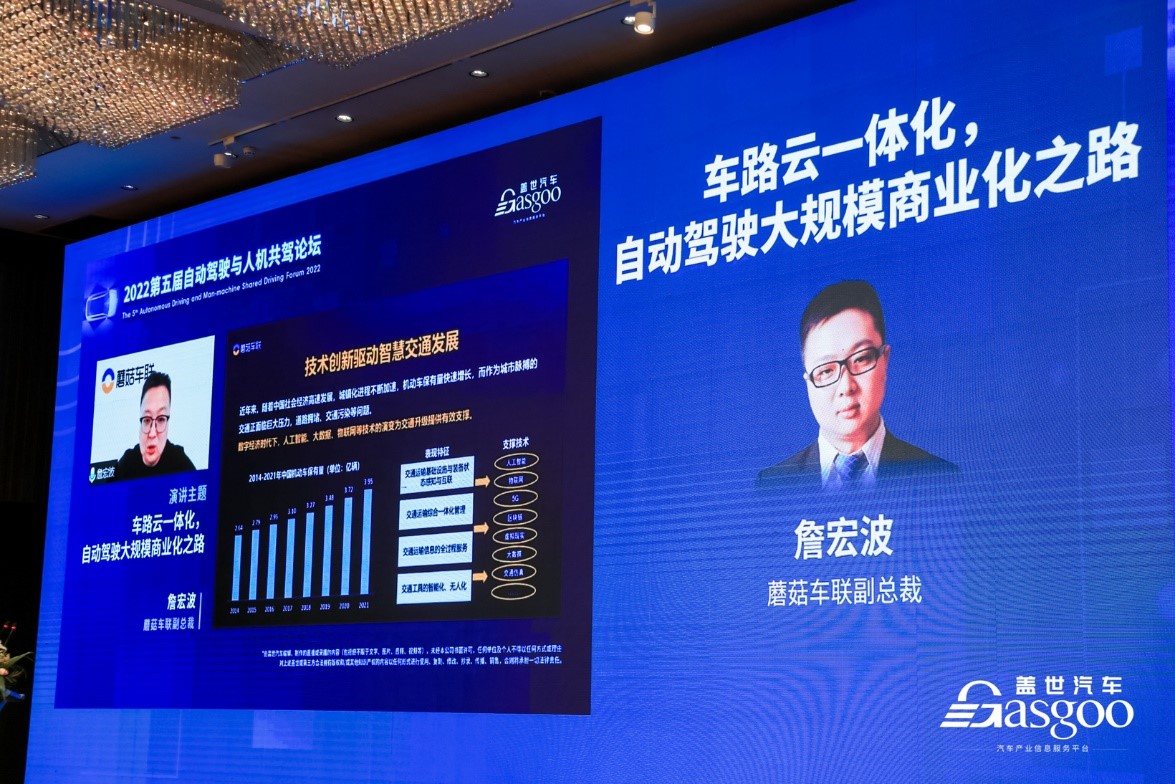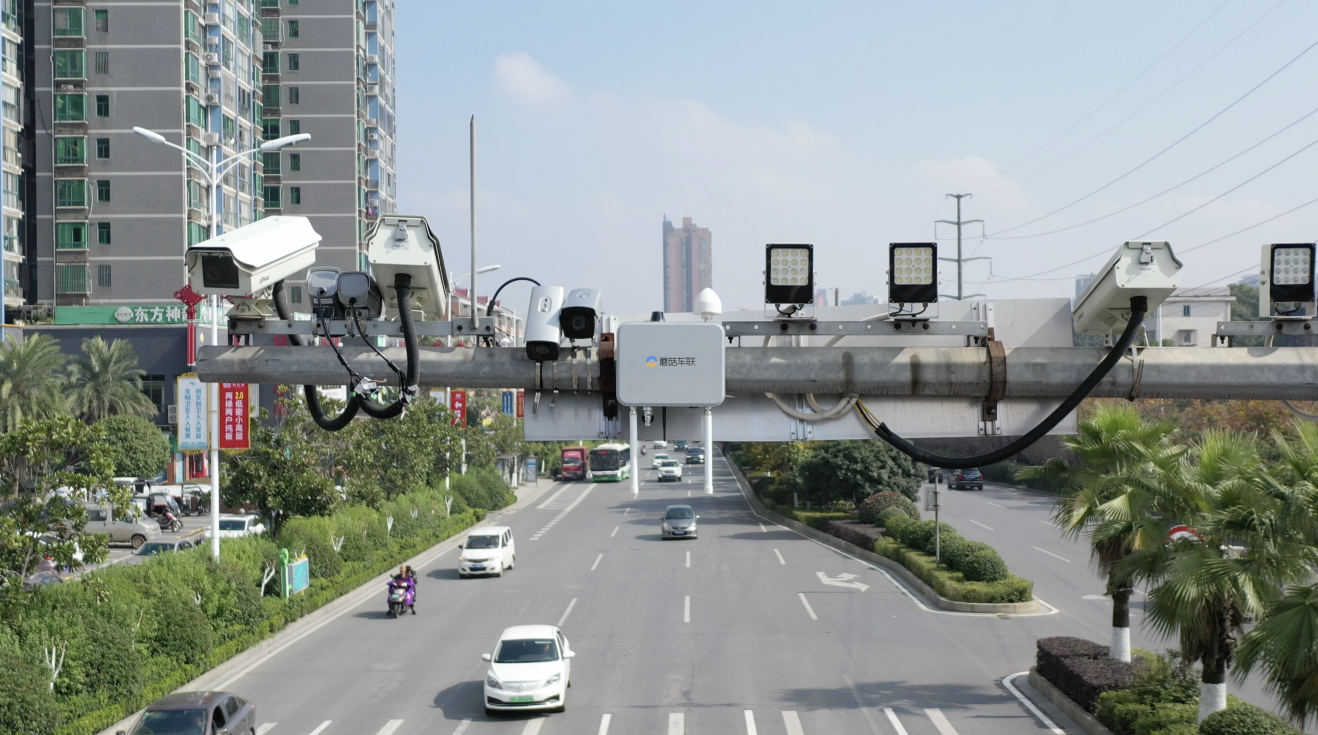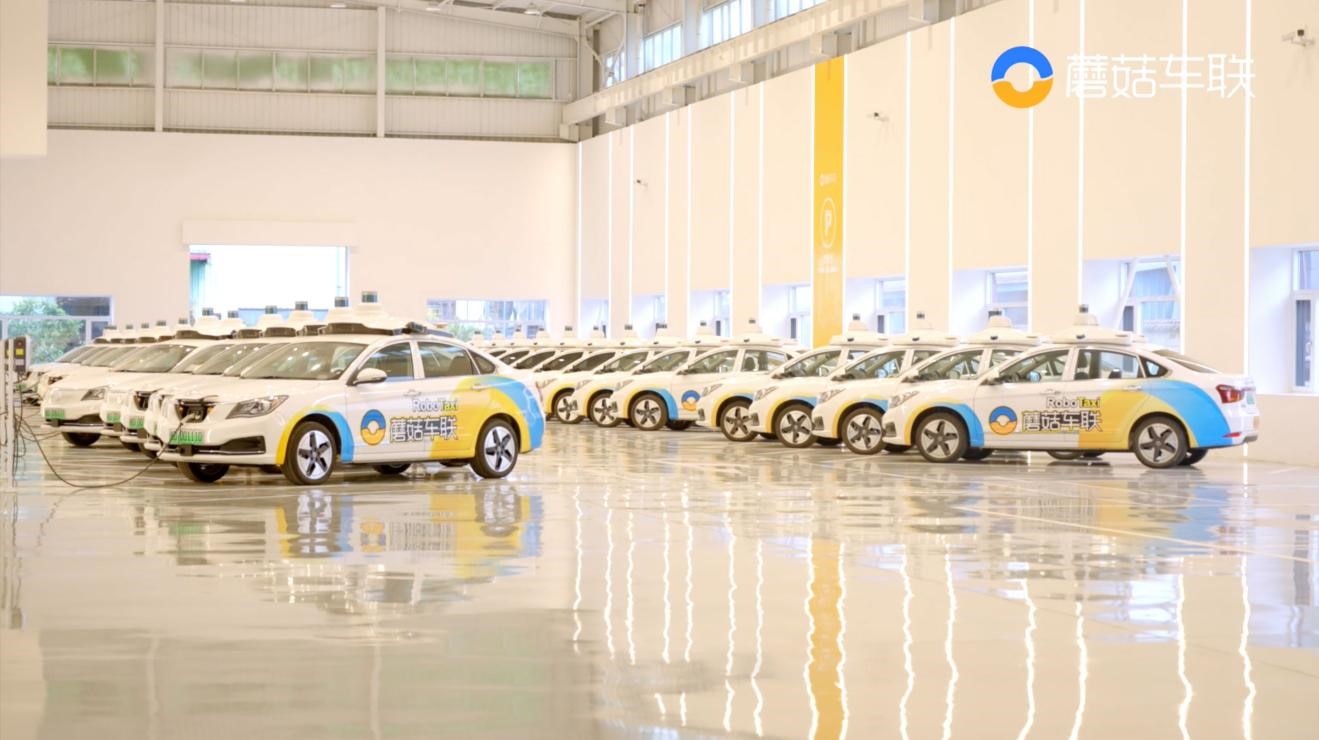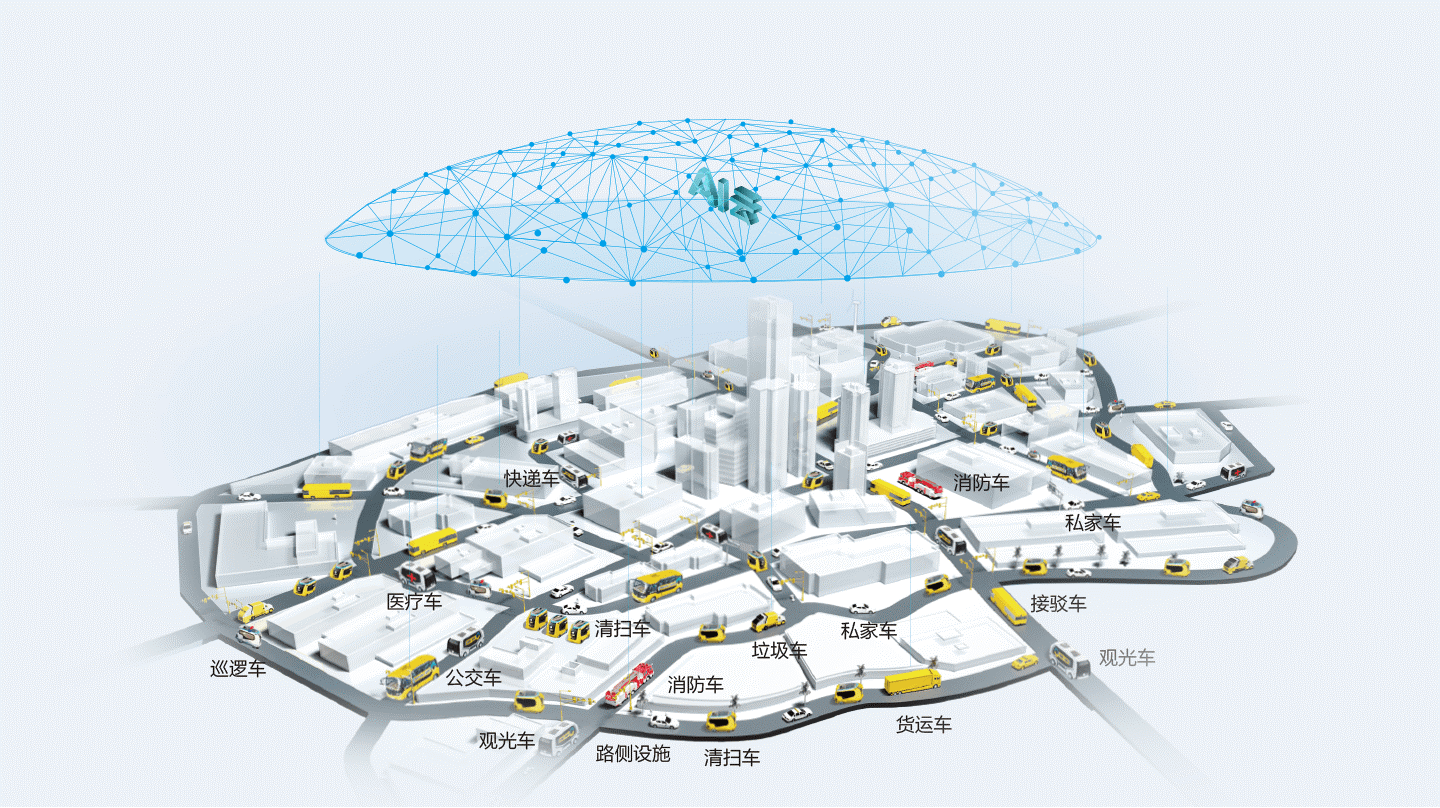Mushroom Autolink is one of the first companies in the industry to propose the "single-vehicle intelligence + vehicle-road collaboration" technical service route. It is the originator and forerunner of the vehicle-road-cloud integration solution, with a full-stack self-developed "vehicle-road-cloud integration" autonomous driving solution, and has the technical capabilities to build new road infrastructure, construct a digital urban base, and operate large-scale city-level autonomous driving public service fleets.
Zhan Hongbo, Vice President of Mushroom Auto Union, gave a speech on the theme of "Integration of Vehicles, Roads and Clouds: The Road to Large-Scale Commercialization of Autonomous Driving". The following is a summary of the speech:

Zhan Hongbo, Vice President of Mushroom Auto Union, delivered a speech entitled "Vehicle-Road-Cloud Integration: The Road to Large-Scale Commercialization of Autonomous Driving"
In recent years, with the rapid development of China's economy, urbanization has continued to accelerate, and the number of vehicles has also increased rapidly. Urban transportation is facing heavy pressure, and traffic congestion and pollution have become increasingly serious problems. In the context of vigorously developing the digital economy, artificial intelligence, big data, and the Internet of Things have become effective supports for building a smart transportation system and upgrading the transportation system.
On the other hand, China's new infrastructure construction has ushered in exponential growth since 2020. Smart transportation with vehicle-road collaboration as the core is an important component of the new infrastructure, and the new infrastructure has become an effective guarantee for the rapid development of smart transportation. The parallel development of the autonomous driving technology route of "single-vehicle intelligence + vehicle-road collaboration" integrates high-level autonomous driving into the field of smart transportation. The development model of "vehicle-road-cloud integration" is attracting many companies to participate, and the autonomous driving industry has ushered in new development opportunities.
In the past three years, the central government has introduced more than 30 policies to support the development of smart transportation, autonomous driving, and vehicle-road collaboration. Local governments have also issued nearly 100 policies to promote the implementation of autonomous driving and vehicle-road collaboration. Among them, Beijing will accelerate the construction of the high-level autonomous driving demonstration zone 3.0 this year and practice the vehicle-road-cloud integrated technology route.

Autonomous driving fleet in the Mushroom Car-Connect vehicle-road-cloud integrated solution
Autonomous driving technology route integrating vehicle, road and cloud
There are two technical routes for autonomous driving. One is single-vehicle intelligence, which deploys cameras, lidar, millimeter-wave radar and other sensor units on the vehicle side, and completes autonomous driving through fusion perception and positioning decision-making for control execution. The other is "single-vehicle intelligence + vehicle-road collaboration", which deploys sensors, communication units, and computing units on both the vehicle side and the road side, and interacts with a lot of traffic information such as people, vehicles, roads, networks, and clouds through C-V2X technology, providing safety redundancy, and achieving upgrades in multiple aspects such as environmental perception, computing decisions, and positioning planning, so as to achieve large-scale commercialization of high-level autonomous driving and improve overall safety and efficiency.
The technical route of autonomous driving has gone through three important time nodes in the process of advancement. The first was the release of the system project document of vehicle-road collaboration by the U.S. Department of Transportation in 2003, which attracted great attention from the academic community at that time. In 2009, Google's autonomous driving project was exposed, and the technical route of single-vehicle intelligence and Robotaxi were sought after by the business, but they could not completely achieve driving safety, and it was difficult to scale and commercialize in the short term. After 2019, vehicle-road collaboration ushered in a great opportunity in the world. China, the United States, Europe and Japan frequently released a lot of policy content related to vehicle-road collaboration and vehicle-road-cloud integration.
There are many technical bottlenecks in single-vehicle intelligence, and vehicle-road collaboration can effectively make up for these technical bottlenecks and greatly improve the safety, stability and reliability of autonomous driving. At the same time, the vehicle-road-cloud integrated solution integrates the vehicle side and the road side, and can also perform global collaborative scheduling through the AI cloud platform. We believe that vehicle-road-cloud integration is the ultimate solution for autonomous driving and the best path to achieve smart transportation, which will also bring great economic and social benefits.
If the intelligence of a single vehicle is regarded as an individual competition, the second half of the individual competition of autonomous driving will develop in the direction of a team competition. Some domestic autonomous driving companies have broken their own boundaries and carried out the overall and system layout of the vehicle, road and cloud, that is, "smart cars run on smart roads", through the coordination of the road side and the vehicle side, and then through the cloud platform to make overall and real-time analysis and decision-making on the vehicle road, so as to achieve safer and more efficient autonomous driving.

Roadside intelligent operating system in the Mushroom Car-to-Car integrated system solution
Vehicle-road-cloud integration ensures large-scale operation of autonomous driving
An important prerequisite for large-scale operation of autonomous driving is safety, but it is also influenced by two major factors: economic benefits and policy orientation.
The vehicle-road-cloud integrated solution can obtain effective information more comprehensively, especially in extreme weather and when the field of vision is blocked. The vehicle-road-cloud integrated solution can provide multiple perception data for a single vehicle through roadside perception, solving the problems of single vehicle perception failure, inaccurate precision, and blind spots. In the event of long-distance traffic accidents such as rear-end collisions and tunnel emergencies, the forward information can be obtained in advance through the roadside and synchronized with the autonomous driving vehicle to prevent secondary accidents. In the event of traffic light failure or no signal lights at intersections, vehicle-road collaboration and vehicle-to-vehicle collaboration can achieve information synchronization to make safer and more reasonable plans.
In addition, the vehicle-road-cloud integrated solution will bring huge economic benefits. First of all, the vehicle-road-cloud integrated solution can help upgrade transportation, achieve refined management, fully empower the urban transportation system, provide real-time information services for various vehicles, reduce accidents and congestion rates, and promote efficiency improvements in various aspects such as urban governance, traffic operation, and public services.
At the same time, the integration of vehicle, road and cloud not only involves the intelligent transformation of vehicles, but also includes the construction of new infrastructure and cloud platforms, which can drive local industrial manufacturing and promote the industrial development of new generation information technology in multiple fields such as intelligent connected vehicles, intelligent manufacturing, infrastructure, and construction, accelerate the upgrading of local industrial clusters, and release economic growth momentum.

The autonomous driving intelligent operation center in the Mushroom Autolink Hengyang vehicle-road-cloud integration project
Vehicle-road-cloud integration helps reduce costs and increase efficiency of urban public services
As a provider of full-stack technology and operation services for autonomous driving, Mushroom Autolink is one of the first autonomous driving companies in the industry to propose the "single-vehicle intelligence + vehicle-road collaboration" technical route. It is the originator and forerunner of the "vehicle-road-cloud integration" solution, with a full-stack self-developed "vehicle-road-cloud integration" autonomous driving solution, and has the technical capabilities to build new road infrastructure, construct a digital urban base, and operate large-scale city-level autonomous driving public service fleets.

Image source: Mushroom Car Union official website
On the vehicle side, Mogo AutoLink independently designs and develops core hardware and Mogo AutoPilot system, including the basic algorithm platform for autonomous driving, ADCU domain controller, high-precision positioning, OBU (on-board communication unit), RTK (real-time differential positioning), 5G-V2X (vehicle networking) communication and other intelligent network core technology products, so as to ensure the reliability and controllability of large-scale implementation of autonomous driving. At present, the system has been adapted to different models and supports large-scale, multi-scenario autonomous driving operation services at the city level.
On the road side, Mogo AutoLink has built an intelligent roadside operating system, Mogo Road System, to solve the problem of limited perception range of bicycles in scenarios such as obstruction by the vehicle in front, obstruction by buildings, and rainy and snowy weather. In fact, the complexity of the roadside is no less than that of the intelligent system of a single vehicle, and it needs to have integrity, such as C-V2X scenario support, including edge-cloud collaboration, and full-link low latency, to build a digital transportation foundation for the city.
Previous article:Leading the localization of in-vehicle high-speed media transmission chips with Chinese standards
Next article:Ming-Chi Kuo: Apple's car team may be reorganized before the end of this year
- Popular Resources
- Popular amplifiers
- Car key in the left hand, liveness detection radar in the right hand, UWB is imperative for cars!
- After a decade of rapid development, domestic CIS has entered the market
- Aegis Dagger Battery + Thor EM-i Super Hybrid, Geely New Energy has thrown out two "king bombs"
- A brief discussion on functional safety - fault, error, and failure
- In the smart car 2.0 cycle, these core industry chains are facing major opportunities!
- The United States and Japan are developing new batteries. CATL faces challenges? How should China's new energy battery industry respond?
- Murata launches high-precision 6-axis inertial sensor for automobiles
- Ford patents pre-charge alarm to help save costs and respond to emergencies
- New real-time microcontroller system from Texas Instruments enables smarter processing in automotive and industrial applications
- Innolux's intelligent steer-by-wire solution makes cars smarter and safer
- 8051 MCU - Parity Check
- How to efficiently balance the sensitivity of tactile sensing interfaces
- What should I do if the servo motor shakes? What causes the servo motor to shake quickly?
- 【Brushless Motor】Analysis of three-phase BLDC motor and sharing of two popular development boards
- Midea Industrial Technology's subsidiaries Clou Electronics and Hekang New Energy jointly appeared at the Munich Battery Energy Storage Exhibition and Solar Energy Exhibition
- Guoxin Sichen | Application of ferroelectric memory PB85RS2MC in power battery management, with a capacity of 2M
- Analysis of common faults of frequency converter
- In a head-on competition with Qualcomm, what kind of cockpit products has Intel come up with?
- Dalian Rongke's all-vanadium liquid flow battery energy storage equipment industrialization project has entered the sprint stage before production
- Allegro MicroSystems Introduces Advanced Magnetic and Inductive Position Sensing Solutions at Electronica 2024
- Car key in the left hand, liveness detection radar in the right hand, UWB is imperative for cars!
- After a decade of rapid development, domestic CIS has entered the market
- Aegis Dagger Battery + Thor EM-i Super Hybrid, Geely New Energy has thrown out two "king bombs"
- A brief discussion on functional safety - fault, error, and failure
- In the smart car 2.0 cycle, these core industry chains are facing major opportunities!
- The United States and Japan are developing new batteries. CATL faces challenges? How should China's new energy battery industry respond?
- Murata launches high-precision 6-axis inertial sensor for automobiles
- Ford patents pre-charge alarm to help save costs and respond to emergencies
- New real-time microcontroller system from Texas Instruments enables smarter processing in automotive and industrial applications
- How is the 0-10V/4-20mA input and output circuit of the inverter usually implemented?
- Two questions about PLL configuration registers
- Engineering Safety Black Box-Submission
- Is there any expert who can tell me how to use the upgrade function of blue_nrg2?
- The editor you've been complaining about for a long time has been updated~
- Hefei recruits 4 mid- and senior-level FPGA
- Today's live broadcast: The latest isolation devices compliant with USB 2.0 standards
- MSP FRAM MCUs Reduce Volatility for the IoT
- micropython update: 2021.2
- The highest prize for celebrating the Chinese New Year at home is 5,600 yuan! Where are you celebrating the Chinese New Year this year?



 MAX916ESE+
MAX916ESE+











 京公网安备 11010802033920号
京公网安备 11010802033920号